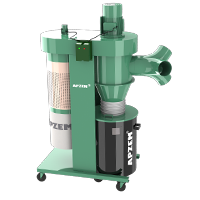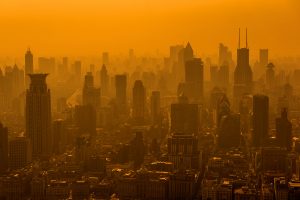Month: February 2022
Dust Collector
Dust Collector https://youtu.be/pe8oVSx1ghc
A dust collection system is a system that removes a particulate contaminant from the air in production facilities, workshops, and industrial complexes. The system has cleaned air by forcing it through a series of airtight filters. Once the air is cleaned, it is expelled outside or recirculated, after it has achieved the proper emission standards.
Many bulk material handling systems are generating dust. Even a dusty foodstuff may be health hazard. Such dust can be damage the lungs and, when suspended in the air in the correct ratios, many organic materials are an explosion risk.

Therefore, the dust collection, air filtration, cleaning up of spilled or settled dust, and the right choice of air handling equipment’s are essential considerations for any bulk materials storage, handling, or processing operation. This Technology Zone offers an insight into the latest innovations in dust collection systems and air pollution control system designs.
Dust collection and the dust extraction ensure a safe and healthy working environment & protect the health operators. Still, installing an industrial filtration or the dust control system can also guarantee the desired functioning of the industrial equipment and improves the production.
Usage tips
The dust collection mechanism or dust collector is highly enhanced. It’s an efficient bio burning makes it second to no cartridge dust collector and the best device for controlling the air pollutions both in a commercial and industrial centers.
https://www.apzem.inAs concerns for the environment have grown, dust collection systems have become a necessity for industries that produce large amounts of dust particles and ambient gases.
Dust collectors have the multiple usages, but their effectiveness and functionality depends on the type of the device. There are various types of dust collectors & various constructions. You can be use the devices for controlling welding fumes and for ensuring that the environment is perfectly ridden of any form of dust or pollutant. The environment is further protected, as well as the pollutants and dusts are not released into the atmosphere.
Uses
In simple terms, a dust collection system is designed as to remove particulates from the air produced during a production operation. This is a short definition is an extreme simplification of the ingenuity required to design and produce a means of capturing harmful contaminants.
Features
The basic components of a dust collection system include a blower, dust filter, cleaning system, receptacle, and means of collecting the particulate matters. The common types of dust collecting equipment’s including a fabric filter baghouse, inertial separators – sometimes referred to as a mechanical cyclone, cartridge collectors, wet scrubbers, and electrostatic precipitators. Baghouse dust collectors are the most commonly used as they have a 99% efficiency.
Dust collection systems have the ductwork to draw in the air, an air purifier, and the dust collector. These basic elements are configured differently for each other type of system.
The first consideration when designing the dust collection system is the ductwork, which may seem to be a simple but has to be carefully considered to ensure proper performance of the system. The size of the pipe used depends on the tool size, air requirements, length of needed pipe, number of machines being serviced, and the types of particulates being extracted.
The dust filter is the air cleaning portion of the dust collection system. There isn‘t any one standard of dust collection filter. In essence, the blower pulls the air from the location into the filter that removes the particulates from the air. The air to cloth ratio is the amount of air that passes through a square foot of the filter
Advantages of effective dust collector:
- The machine is capable of handling the high-volume dust particles.
- Auto filter cleaning system.
- Remove the unwanted substances from the gas and the air, effectively.
- Purifies the air very fast and has been the ability to work continuously, without any issues.
Air Pollution – Health Risk of ADHD
Air Pollution – Health Risk of ADHD
Air Pollution – Health Risk of ADHD is one of the most prevalent neurodevelopmental disorders. Affecting up to 5-10% of children, it can be bought on by exposure to the environmental toxic like a lead, maternal drug use, alcohol use or smoking during pregnancy and now, air pollution.
ADHD Affected in Child
ADHD is a common neurodevelopmental condition in children, which sometimes continues in adulthood. It is a complex condition, difficult to diagnose, and with no curable. If left unchecked, ADHD can be impact children’s performance at school and their relationships with parents and peers. It is a more common in boys than girls and it affects 1 in 20 children.
Neurodevelopmental Disorder
The research, published in the journal Environment International, found that children living in the greener and less polluted areas have a 50 per cent lower risk of developing ADHD, one of the most prevalent neurodevelopmental disorders.

Air Pollution – Health Risk of ADHD Children who live in greener, less polluted places have a 50% decreased risk of having ADHD, one of the most common neurodevelopmental disorders, according to study published in the journal “Environment International”. Children who are exposed to a lot of pollution are more likely to develop ADHD.
Data on ADHD cases was obtained from hospital records, physician visits, and prescriptions during the study, which spanned the years 2000 to 2001.
The disorder is generally diagnosed during the first years of school but it can be manifest differently from child to child. It is cause, however, has been a subject of debate among researchers. In 2018, a study identified regions of the DNA associated with ADHD, for instances. But scientists have also been studying other factors, with no clear answers on many of them as far. This is due to Air Pollution affects the health risk of ADHD.https://youtu.be/iMTXlIIVVrE
Air Pollution – Health Risk of ADHD
The percentage of green space in the participants’ neighborhood was calculated using a new and exact satellite metric, and the residential levels of two air pollutants — NO2 and PM 2.5 – as well as noise levels were calculated using existing exposure models.
Study Result
The results are consistent with previous studies, which found associations between the green space and air pollution, respectively, with ADHD. However, the most of the research conducted until now focused on the evaluation of single exposures and rarely evaluated joint effects of multiple environmental exposures.
This study identified a total of 1,217 ADHD cases, which represents 4.2% of the sampled population. The participants living in areas with a larger percentage of vegetation had a lower risk of ADHD. More specifically, the study showed that a 12% increase in vegetation was linked with a 10% drop in the risk of having ADHD.
The outcomes have been in keeping with earlier research, which discovered associations between the inexperienced house and the Air pollution, respectively, with ADHD. Nevertheless, many of the analysis performed till now centers on the analysis of single exposures and the infrequently evaluated joint results of a number of environmental exposures.
“We are noticed that the kids are dwelling in greener neighborhoods with a low Air pollution had a considerably decreases of dangerous ADHD. That is an environmental inequality the place, in flip, these kids are dwelling in areas with a larger air pollution and the fewer greenness face a disproportionally larger.
Air Pollution – ADHD
While the direct link between the air pollution and the development of ADHD isn’t fully understood, researchers list several possibilities, including disruption of the endocrine system, DNA damage, oxidative stress, and interference with placental growth factors resulting in decreased exchange of oxygen and nutrients.
“These associations are significantly related as the results of exposures happening in formative year, an important interval for mind growth place kids are particularly susceptible. Importantly, these exposures are modifiable, that means that the findings need to be taken under consideration for healthier city planning,” she added.
Healthy Air from Your Home
Protecting your family’s health begins with the health of your home.
Low level Air Pollution – Harm Health
Low Level Air Pollution – Harm Health : Air pollution is made up of both gaseous and particulate matter. Each year almost two million people die as a direct result of the air pollution with many more experiencing impaired lung function, developing lung diseases such as asthma and chronic obstructive pulmonary disease. However, research, on the effects of low level air pollution, is often an overlooked.
Air pollution is the world’s largest killer & responsible for thousands of people deaths worldwide every year. CO2, SO2, NO2, O3, particulate matter, and PM 2.5 is the major contributors of indoor air pollutions. It is the result of combustion from space heating, industrial and vehicular emission, which causes and exacerbates several diseases such as asthma cancer, pulmonary illnesses. Not only these, but there are also different effects of air pollution on human health.
Low Level Air Pollution – Harm Health Impacts
- Irritation of eyes, nose, and throat
- Wheezing, coughing and problem in breathing
- Worsening of lungs & heart problems
- Increased risk of heart attack.
Health Effects from Specific Pollutants
Researchers assessed in three components of the air pollution – fine particulate matter, NO2, O3. Each a unit of increase in levels those pollutants was associated with thousands of hospital admissions a year, the study found.
The researchers say that people living alongside major traffic corridors needs to be an aware of the potential adverse effects on their respiratory health.
Air pollution can be harm the heart and lungs by triggering inflammation in the heart and throughout the body, the researchers said.
In terms of specific pollutants, higher risks of heart attack, stroke, and flutter, as well as pneumonia were associated with a long-term exposure to particulate matter.
Long-term exposure to NO2 was associated with an increased risk of stroke
At the age of eight, study participants are undergoing lung function tests. In addition, children who experienced the greater improvements in air quality after the first year of life, either due to a move or changes in local pollution, had better lung function compared to those who air quality did not improve as much.
Researchers are analyzed medical records of more than 63 million Medicare patients from 2000 to 2016. They found that the long-term exposure to low levels of air pollution could increase the risk of heart attack, stroke, and the irregular heart rhythm.
The Effects of Air Pollution on Human Health
In terms of specific pollutants, higher risks of heart attack, stroke, a-fib and flutter, as well as pneumonia were associated with long-term exposure to particulate matter.
Smoke from factory wastes and other visible & invisible substances produced by humans and incorporated into the atmosphere system causes the air pollution, leading to global warming Effect.
CO2 is one of the most harmful environmental pollutants in the air. In addition of methane from swamps and livestock, chlorofluorocarbons (CFCs) previously used in refrigeration and the propellant fuels, their use has been banned due to their destructive impact on the ozone layer Effect.
These gases and compounds can be cause significant changes in the climate, increase the rate of smog such as infections of the upper respiratory tract, allergies.
Studies shows that 9 out of 10 people breathe air that contains high levels of pollutants permanently.
Air pollution leads to the deaths about to 7 million people worldwide every year. It contributes into stroke and causes 1.4 million deaths each in year from strokes.
Air pollution is not only harms human health but also causes environmental effects. It can be directly contaminating the surface of water bodies, soil and even kill crops or reduce their yield.
Potential Health Effects
The potential health effects of air pollution range from subtle physiological changes inside the body to florid symptoms such as nose and throat irritation, shortness of breath, coughing and chest tightness. People suffering from asthma or chronic respiratory diseases will experience an increase in symptoms when exposed to air pollutants. Although individual’s reaction to air pollutant depends on various factors, people of all age groups are affected by poor air quality. Vulnerable groups such as children and the elderly are especially susceptible to the effects of air pollution.https://youtu.be/d9K6JqFBrvA
Air Pollution – Heart Related Hazards
Air Pollution – Heart Related Hazards
We know that what we’re looking at when brown haze settles over a city, exhaust billows across a busy highway, or a plume rises from a smokestack. Some air pollution is not seen, but its pungent smell alerts for you.
According to The American Heart Association, someone dies from cardiovascular disease every 40 seconds in the United States. Almost half of an Americans have at least one of three main risk factors for heart disease, high blood pressure, high cholesterol, and a smoking habit. Doctor’s tells their patients to exercise more, watch what they eat, and to quit smoking to lower their cardiovascular risk, but there are other factors that we should be also recognize as having an impact on our heart health, like air pollution exposure.
An association between the high levels of anthropogenic air pollutants and human illnesses has been known for more than half of a century. A few episodes of markedly increased of mortality rates during extreme elevations in urban pollution.
Air Pollution – Heart Related Hazards
Each year, an American Heart Association, in conjunction with the Centers for Disease Control and Prevention, National Institutes of Health & other government agencies, compiles up-to-date statistics on heart disease & other Heart vascular diseases.
Pollution can come from traffic, factories, power generation, wildfires or even cooking with a wood stove. One of the most common indoor sources is smoking, a dangerous to the person lighting up and to those nearby.
MESA
MESA Air provides evidence that the long-term exposure to air pollution is a cardiovascular disease risk factor, that should be taken as seriously. In addition of encouraging policy makers to consider as the long-term impacts of low levels of air particle pollution and motivating healthcare providers to the effects of air pollution on the cardiovascular system, the study emphasizes the importance of monitoring air quality to protect heart.
People are breathing in air pollution like carbon monoxide and particulate matter, which are tiny air particles composed of noxious substances. Some researchers are concerned about particulates that is 2.5 micrometers or smaller, which is most commonly found in car exhaust. The small size of these particulates are allows them to easily enter the body and poses a greater risk to the circulatory system than other common pollutants.
Medical researchers are particularly concerned about pollution particles smaller than 2.5 microns, which are usually related to fuel combustion. Because they are so tiny, they aren’t easily screened and more readily enter the human body. Then they begin to irritate the lungs and blood vessels around the heart. Data suggests that over time pollutants aggravate or increase the process of disease in the arteries.
Avoiding Air Pollution when You Have a Heart Condition
While it is nearly impossible to avoid all the forms of air pollution, it is recommended that heart disease patients avoid spending a long periods of time in areas of high pollution, such as near busy roads, factories or railways.
Being physically active can be improve heart and circulatory health, but consider reducing the amount of exercise have done outdoors if the air pollution in your area is high.
Epidemiology studies have used blood and urine to look for mechanistic markers for the cardiovascular changes.
Range
- 6.9 percent increase in out-of-hospital cardiac arrests, with a stronger association between the pollution and cardiac arrests in men and people 65 and older.
- 2.07 percent increase in emergency department visits for ischemic heart disease.
- 1.86 percent increases in hospitalizations for ischemic heart disease, with a stronger association in women and people 65 and older.
- The risk of death is greater from long-term exposure. Current science suggests air pollution facilitates atherosclerosis development and progression, said the scientific panel that worked on the statement. It also may play a role in high blood pressure heart failure and diabetes.https://youtu.be/d9K6JqFBrvA
Pandemic Situation has Affects the Air Pollution
Pandemic Situation has Affects the Air Pollution : The outbreak of COVID-19 has created a global health crisis. Most of the countries in the world have been affected by COVID-19 infections. However, some regions have been more badly affected in terms of infections and fatality rates than others. These remarkable variations have raised significant questions related to the influence of air pollution to the extent of COVID-19 infections, and its mortality rate around the world.
Pandemic Situation has Affects the Air Pollution : We know that air pollution can cause health problems, like heart attacks, strokes, diabetes and high blood pressure, that have been identified as the pre-existing medical conditions that to raise the chances of death from COVID-19 infection. Recent study made by Harvard T.H. Chan concluded that breathing more polluted air over many years may itself worsen the effects of COVID-19.
According to the World Health Organization, air pollution kills an estimated seven million people worldwide every year. Almost 99% of the global population breathe air that exceeds of guideline limits on pollutants.
Air pollution kills an estimation of seven million people per year, according to the World Health Organization
How lockdowns affected air pollution
We know that air pollution can cause health problems, like heart attacks, strokes, diabetes and high blood pressure, that have been identified as the Pre-existing Medical conditions that raises the chances of death from COVID-19 infection.
Country by country, region by region, the emergence of the coronavirus changes a life as we know. Entire populations were locked down and forbidden from the travelling of anything but essential and emergency purposes. Data from the International Energy Agency showed as the, by the end of March 2020, global road transport activity fell by almost 50% year on year.
While the study does not show that the air pollution directly affects an individual’s likelihood of dying from COVID-19 because individual-level of COVID data’s are not yet publicly available, it does show an association between long term exposure to air pollution and higher COVID-19 mortality rates of that pandemic Situation has affects the Air Pollution.
Hope for a cleaner future
It’s hoped that our brief experience of cleaner air will drive our desire to keep it. While pausing leisure and economic activity isn’t a healthy way do it, these shutdowns can offer valuable lessons moving forward.
Particulate matter can cause a variety of health concerns, and persons who already have a lung or heart condition are more likely to be harmed. The size of a pollutant particle is thought to determine the harm it poses to the body. This way the pandemic situation has affects the Air Pollution.
Although in cities and large towns like Glasgow, Warrington and Oxford, NO2 concentration levels more than halved during lockdown, not at all cities and large towns experienced a significant improvement in air quality.
prevention
- Wash hands frequently, use a sanitizer and maintain a physical distance of at least 2 meters.
- Use as a good quality mask, preferably an N95, N99 or N100 mask as they have the ability to filter out the finest particles.
- Patients who have recovered from the COVID-19 must be extra cautious as the disease tends to decrease lung function and increased level of pollution may aggravate their health problems.
- People must try to remain indoors and non-step out of their houses unless necessary.
- Early morning jogs must be avoided as their pollution levels are at a peak during those hours.
- When restrictions were lifted, air pollution returned to its pre-pandemic levels in 39 of 49 cities and large towns studied, even though none had returned to previous levels of economic activity.
- The coronavirus pandemic has been lead to an increase in air quality all around the world. Lockdowns have the resulted in factories and roads shutting, thus reducing emissions.https://www.apzem.in




